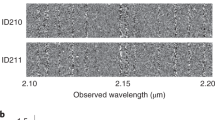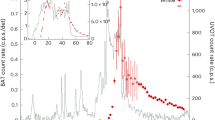Abstract
The origin of γ-ray bursts has been one of the great unsolved mysteries in high-energy astrophysics for almost 30 years. The recent discovery of fading sources at X-ray1 and optical 2,3 wavelengths coincident with the location of the γ-ray burst GRB970228 therefore provides an unprecedented opportunity to probe the nature of these high-energy events. The optical counterpart appears to be a transient point source embedded in a region of extended nebulosity 3–6, the latter having been tentatively identified as a high-redshift galaxy3. This would seem to favour models that place γ-ray bursts at cosmological distances, although a range of mechanisms for producing the bursts is still allowed. A crucial piece of information for distinguishing between such models is how the brightness of the optical counterpart evolves with time. Here we re-evaluate the existing photometry of the optical counterpart of GRB970228 to construct an optical light curve for the transient event. We find that between 21 hours and six days after the burst, the R-band brightness decreased by a factor of ∼40, with any subsequent decrease in brightness occurring at a much slower rate. As the point source faded, it also became redder. The initial behaviour of the source appears to be consistent with the 'fireball' model7, but the subsequent decrease in the rate of fading may prove harder to explain.
Similar content being viewed by others
References
Costa, E. et al. IAU Circ. No. 6576 (1997).
Groot, P. J. et al. IAU Circ. No. 6584 (1997).
Van Paradijs, J. et al. Transient optical emission from the error box of the γ-ray burst of 28 February 1997. Nature 386, 686–689 (1997).
Sahu, K., Livio, M., Petro, L. & Macchetto, F. D. IAU Circ. No. 6606 (1997).
Sahu, K. et al. IAU Circ. No. 6619 (1997).
Sahu, K. et al. The optical counterpart to γ-ray burst GRB90228 observed using the Hubble Space Telescope. Nature 387, 476–478 (1997).
Mészáros, P. in Proc. 17th Texas Sympos. on Relativistic Astrophysics; Ann. NYAcad. Sci. 759, 440–445 (1995).
Costa, E. et al. IAU Circ. No. 6572 (1997).
Groot, P. J. et al. IAU Circ. No. 6588 (1997).
Metzger, M. R. et al. IAU Circ. No. 6588 (1997).
Thé, P. S., Steenman, H. & Alcaino, G. Relations between spectral types, absolute magnitudes, and colour indices of red dwarfs in the Cousins photometric system. Astron. Astrophys. 132, 385–388 (1984).
Johnson, H. L. Astronomical measurements in the infrared. Annu. Rev. Astron. Astrophys. 4, 191–206 (1966).
Bessell, M. S. UBVRI photometry. II-The Cousins VRI system, its temperature and absolute flux calibration, and relevance for two-dimensional photometry. Publ. Astron. Soc. Pacif. 91, 589–607 (1979).
Bessel, M. S. UBVRI Photometry with a Ga-As photomultiplier. Publ. Astron. Soc. Pacif. 88, 557–560 (1976).
Holtzman, J. A. et al. The photometric performance and calibration of WFPC2. Publ. Astron. Soc. Pacif. 107, 1065–1093 (1995).
Guarnieri, A. et al. IAU Circ. No. 6582 (1997).
Pedichini, F. et al. IAU Circ. No. 6635 (1997).
Margon, B., Deutsch, E. W., Lamb, D. Q. & Castander, F. J. IAU Circ. No. 6618 (1997).
Metzger, M. R. et al. IAU Circ. No. 6631 (1997).
Yoshida, A. et al. IAU Circ. No. 6593 (1997).
Wijers, R. A. M. J., Rees, M. J. & Meszaros, P. Shocked by GRB970228: the afterglow of a cosmological fireball. Man. Not. R. Astron. Soc. (submitted).
Piran, T. in Compact Stars in Binaries (eds van Paradijs, J., van den Heuvel, E. P. J. & Kuulkers, E.) 489–502 (Proc. IAU Symp. 165, Kluwer, Dordrecht, 1996).
Eichler, D., Livio, M., Piran, T. & Schramm, D. Nucleosynthesis, neutrino bursts and gamma-rays from coalescing neutron stars. Nature 340, 126–128 (1986).
Author information
Authors and Affiliations
Rights and permissions
About this article
Cite this article
Galama, T., Groot, P., van Paradijs, J. et al. The decay of optical emission from the γ-ray burst GRB970228. Nature 387, 479–481 (1997). https://doi.org/10.1038/387479a0
Received:
Accepted:
Issue Date:
DOI: https://doi.org/10.1038/387479a0
- Springer Nature Limited
This article is cited by
-
Observations and physics of prompt emission of gamma ray bursts
Journal of Astrophysics and Astronomy (2018)
-
The afterglow, redshift and extreme energetics of the γ-ray burst of 23 January 1999
Nature (1999)
-
Optical afterglow of the γ-ray burst of 14 December 1997
Nature (1998)





